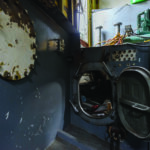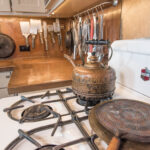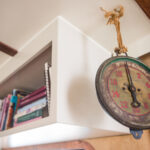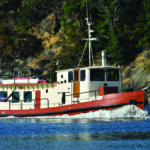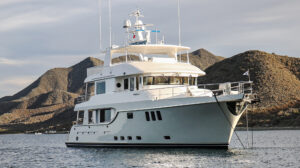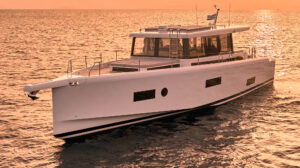
One Thursday morning, Michel awoke and realized that in three days, five welders would arrive to literally pull the roof off of his new home, and he had nowhere else to live. As he sipped his coffee that morning amid a maze of tools and scrap metal on his new-to-him 60-foot harbor patrol boat built in 1956, the abandoned and stripped-down Coronado 32 across the dock suddenly came into focus. Bingo. Two hours later, Michel pulled his second dilapidated floating home alongside his first and grabbed the power washer.
He spent hours scrubbing the moldy little sailboat-inside and out-to make it habitable. The Coronado needed lights, so he cut them out of the big boat and installed them next door. Bilge pump? Just hook it up. Freshwater pump? Toss it over. With a functional home freshly cleaned and updated in a day, Michel tossed his belongings from the deck of the harbor patrol boat into the Coronado’s cockpit and moved himself in. When the welders showed up on Monday morning, they found an empty powerboat ready to be gutted.

The Water Beckons
Eight years before that fateful morning, Michel owned a home (on land) and commuted to work much like the rest of us. But he was ready for something different. He was weary of being rooted to the ground.
There were two things that drew him to a life on the water. First, life is simpler aboard a boat. Everything a liveaboard consumes must be hauled down a dock, onto the deck, and into the boat. This little bit of extra effort encouraged Michel to be a more conscious consumer. And second, while a house is built with the intention of buffering its inhabitants from the outside world, with insulated walls and double-paned windows, electric fireplaces and air conditioning, a boat is built to cooperate with the elements, bringing its inhabitants more in tune with the world around them. When the wind blows, the boat moves. When the tide is low, the ramp on the dock is steeper. When it rains, it probably leaks inside somewhere.
And so, ready to cut ties with land, Michel decided to buy a liveaboard/cruiser. Before this, he had never before owned anything bigger than a 16-foot ski boat, but Michel could sense that living aboard was the right lifestyle choice for him. His first liveaboard was an Angel 60 that had burned in a fire, so he got the boat for a song. He dove head-first into a total restoration, which exemplifies how Michel approaches challenges in life. From land-lubbing one day to living aboard the next, from no experience with refits to embarking on a total restoration—Michel’s zeal accelerates from zero-to-60 in no time flat.
After several years of an impressively steep learning curve, the Angel 60 restoration had been completed, but Michel was ready for his next challenge. Along the way, he determined the Angel didn’t quite suit his personality. She was a bit too “yachty” for his tastes; she required too much maintenance and was temperamental at sea. This made the boat difficult to single-hand, nerve-wracking to dock, and expensive to keep up. Soon after the refit was complete, Michel sold her and turned to his next challenge.
Refit of a Classic

Michel is an adventurous, generous, and fun-loving soul. Among other things, he has lived internationally, worked in corporate America, biked across Italy, and started his own catering business. He lives on an island and drives a well-loved Volkswagen diesel hatchback from the early 2000s. It was no surprise to the people who know him when Michel bought an abandoned 1956 harbor patrol boat with the intention of completely gutting and restoring it while living onboard. If you ask him about finding this treasure, it is apparent how well matched he and that boat really are. He gets a dreamy look in his eyes. “It was love at first sight,” Michel says. The lines were sleek and classic; the hull stout and resilient. He could envision a beautiful cabin layout, homey and inviting, but with no teak or stainless steel to maintain. With a low profile and two rumbling engines, it would be easy to single-hand. Best of all, the price was just right.
To add to the allure, the boat came with a colorful and impressive history. “Harbor Patrol Boat #1” was built in 1956 to fight fires in Portland, Oregon. After 50 years of active duty in Portland, she motored up the Snake River to serve as a fireboat in Idaho for five years. After that, she found her way to Seattle only to sit, abandoned and dilapidated, until Michel wandered by in 2016, instantly devoted despite the thick coats of mold and rust.
Rebuild Begins

He got straight to work. Much of the demolition he did by himself, a grueling task that he would not wish on anyone. Without professional equipment or knowledge, he cut each interior bulkhead out with an angle grinder, resulting in three separate hospital visits. The wiring was sheathed in stainless steel, which required more use of the angle grinder. On a break one afternoon from the never ending back-breaking labor, Michel sipped a Diet Coke and did some back-of-the-napkin math. He had been at it for five months. At this rate, it was going to take him more years than he had to finish this job alone. So he found a team of professional welders to complete the major structural work.
This was no small welding job. Michel initially hired the welders for two months, but ended up extending their services for another three months. In this time, they tackled such projects as lowering the saloon floor, raising the galley ceiling, adding covered walkways, cutting out and patching all six exterior doors, and relocating and expanding every window on the boat. At the end of it, the hull and pilothouse were the only unmodified steel structures on the boat.Mi

While the welders toiled away in the cabin, a team of mechanics assaulted the engines. The boat was powered with twin 330-horsepower two-stroke GMC 871s. When he bought the boat, Michel dreamed of repowering with shiny, fancy, newfangled motors. He worried the 871s would be too loud, too thirsty for oil, and too leaky. But the mechanic convinced him to at least do the maintenance required to turn them over and test them out. When he heard them crank over for the first time, Michel was smitten. And besides, he just couldn’t make the math work to justify new motors. The 871s burn 10 gallons per hour while shiny new ones would probably burn about seven. At approximately $100,000 for the replacement job, how many hours would it take to make that investment back? He didn’t have to run the numbers to know it wasn’t a good investment. (The answer is 8,333 hours, or 347 days of running 24 hours a day.)
The guttural rumble of the 871s suited the boat. They are simple and reliable engines, without complex computer systems that could glitch. Parts are easy to find and repairs are straightforward. While it was now clear the old GMCs got to stay, they still needed an enormous amount of attention. Initially, the engine mounts were welded directly to the boat’s frame, which caused the whole boat to shake and shimmy like a ‘70s dance party. That would not do. So Michel and his team cut the engines from the frame, hoisted them 6 inches, built new hard mounts on top of soft ones, recalibrated the shaft angle, replaced all hoses and gaskets, bought new propellers, installed all new sending units, and scrubbed every crevice with a toothbrush. Once back together again, those 871s have rumbled along without a single complaint.

Back up in the cabin, the welders had finally packed up and gone home. If this was a house instead of a boat, the equivalent would be like having all the framing in place, and very little else. The interior spaces were defined, but only by raw metal and angled iron studs with giant holes for the windows and doors. The hard work was done, Michel thought optimistically. It’s time for the woodwork, which would certainly be quicker and easier than metalwork.
A Work in Progress

That was wishful thinking, of course. The number of layers required to get a smooth and enduring finish was baffling. First, spray primer over the metal. Then lay down a vapor barrier. Then prime the vapor barrier. The biggest fear in owning a metal boat is that it will stealthily corrode from the inside out, often due to its own condensation. These first three layers are to keep the inside of the boat dry. Then the woodworkers had to through-bolt 2x2s to the angle iron studs and shape plywood to fit smoothly over the walls and ceilings. It took them nine months to put the walls up. Already 19 months into the restoration, they had just reached the equivalent step of installing drywall.

Finally, the bulk woodwork was complete. Michel took a deep breath. He had finished the long and arduous tasks of welding and woodworking. Once again he was certain he was past the slowest and trickiest parts of the project. Then the finish work started. The finish work, it soon became apparent, was going to be an even slower process than the previous stages of the renovation. The changes were miniscule and unendingly time consuming.
Burnout
Everyone that has undertaken a renovation project (or any boat project, really) understands that there are breakdown moments. Michel had his when he realized that with the rate he was working, even with the help of professionals, the finish work was going to take years, not months, to complete. He was burning himself out, with no view of the finish line. At this point, his home had been a construction zone for almost two years. His budget was stretched, his body hurt, and his life was frazzled.
So he took a break. He brought the boat to a functional point, including having pressurized water, a working toilet, doors, light switches, and a stove, then put away the tools, cleaned up the sawdust, postponed all work, and just lived on the boat for two years. It was a crucial move for his sanity. This year, he has started to wade back in to the projects. He is slowly but surely finishing the interior spaces. But he is reengaging with a level of insight, knowledge, support, and leniency he did not have two years ago. He is tackling the rest of the renovation with three hard-learned tenets in mind:

First, be nice to yourself. The angst and stress of renovation projects are self-inflicted. There is no boss commanding you to finish the plumbing by next week, check off every item on the list today, or do the project perfectly on the first try. The work is a lot more fun when there is less pressure.
Second, triple your budget. The common adage when taking on a boat project is to double the budget, but in Michel’s experience, that’s not nearly enough. The quickest way to burn out is to be considerably over budget and constantly stressed about it.

And third, use your resources. The people around you have great ideas and know things you don’t. Some of Michel’s favorite elements of the refit have come from the ideas generated by others. He discusses design challenges or technology options with friends and neighbors, asking for input and initiating discussion. This has the added bonus of bringing a social and communal element to the endeavor.
Michel is looking forward to completing the renovation of his boat, but he is not in a rush. He has set no deadlines and allows himself plenty of slack to put down the tools and head to the Canadian Gulf Islands for a week (or three). He enjoys working on the details, steadily transforming his liveable construction zone into his forever home. Despite the stress and struggle of taking on a renovation of this scope, he loves the lines and the rumble of that boat as much today as he did the first day he laid eyes on her.
An interior detail.
Exterior detail of this renovated harbor patrol boat.
Two natural beauties, that of this patrol boat and of British Columbia’s wilderness.
Details of an experienced boater, leather lashings to keep drawers closed in the workshop.
A workboat like this has lots of nooks and crannies.
As a former chef and caterer, Michel’s galley alway receives dedicated attention.
The 1936 build plate.
Galley detail.
Underway







